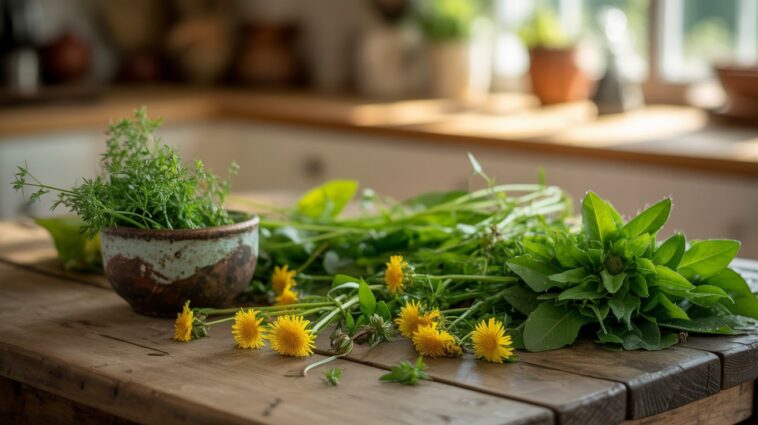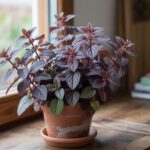When I first started gardening seriously, I spent so much time trying to pull every last weed out of my vegetable beds. I was convinced they were all freeloaders, stealing nutrients from my prized tomatoes and lettuces. But over time, something shifted. I began to wonder what those weeds actually were—what if some of them had value?
That curiosity led me down a rabbit hole, and what I discovered changed my gardening life: many of the so-called “weeds” I was yanking out and tossing into the compost bin were actually edible—some even more nutritious than the crops I was trying to protect.
Now, I don’t look at weeding as a chore. I look at it as foraging. Here are 15 common edible weeds you might already have growing in your yard, hiding in plain sight.
1. Dandelion (Taraxacum officinale)
The poster child of edible weeds. Every part of the dandelion is edible: the bitter greens, the bright yellow flowers, and even the roots. I use the leaves in salads, sauté them like spinach, and make tea from the roots. The flowers? They make a surprisingly tasty jelly or wine.
2. Chickweed (Stellaria media)
This soft, sprawling little plant often carpets my garden paths in spring. Chickweed tastes mild and slightly grassy, perfect raw in salads or tossed into a stir-fry. It’s rich in vitamins A, C, and iron.
3. Purslane (Portulaca oleracea)
This succulent, ground-hugging weed has a lemony tang and an incredible crunch. It’s one of the best plant sources of omega-3 fatty acids. I love it tossed into summer salads or chopped into yogurt with a sprinkle of salt.
4. Lamb’s Quarters (Chenopodium album)
Sometimes called wild spinach, this tall, leafy plant grows like crazy once it shows up. The leaves have a slight powdery coating and cook down just like spinach. I use them in omelets, soups, or mixed with other greens for a wild twist on classic dishes.
5. Plantain (Plantago major and P. lanceolata)
No, not the banana-like fruit—this is the low-growing plant with broad or lance-shaped leaves. The young leaves are edible (though a bit tough) and can be sautéed. I also use it as a natural remedy for bug bites and stings—just crush the leaves and apply.
6. Wild Violet (Viola sororia)
I used to think wild violets were just pretty weeds, but their leaves and flowers are edible. The heart-shaped leaves are mild, and the violet blossoms are beautiful candied or tossed fresh onto desserts or salads.
7. Shepherd’s Purse (Capsella bursa-pastoris)
This delicate little plant with heart-shaped seed pods has a peppery taste reminiscent of arugula. I often add a few chopped leaves to soups or salads when I want a little kick.
8. Garlic Mustard (Alliaria petiolata)
An aggressive invasive in many areas, garlic mustard is also completely edible. Its leaves have a garlicky, mustardy flavor that makes a wonderful pesto. Just harvest responsibly—this one’s doing more harm than good in the wild.
9. Wood Sorrel (Oxalis spp.)
Those clover-shaped leaves with the bright citrus zing? That’s wood sorrel. Kids love it for its sour-apple taste. I use it sparingly in salads or as a garnish—it’s rich in oxalic acid, so moderation is key.
10. Creeping Charlie (Glechoma hederacea)
Also called ground ivy, this creeping plant smells like mint when crushed. It’s part of the mint family and can be used like a culinary herb. I’ve brewed it into tea and even infused vinegar with it.
11. Nettle (Urtica dioica)
Yes, it stings. But once cooked or dried, nettles lose their sting and become a powerhouse of nutrition. I always wear gloves to harvest it, then use the leaves in soups, teas, and even pasta dough.
12. Curly Dock (Rumex crispus)
Curly dock grows in compact rosettes with wavy leaves. The young greens are edible when cooked—raw, they’re too bitter for my taste. Like sorrel, they’re high in oxalic acid, so enjoy them as an occasional wild treat.
13. Wild Amaranth (Amaranthus retroflexus)
Also known as pigweed, this tall summer annual produces protein-rich leaves and nutritious seeds. I cook the greens just like spinach or collards and sometimes collect the seeds for baking.
14. Mallow (Malva neglecta)
This weed pops up in neglected corners of my yard with big round leaves and delicate purple flowers. The leaves are mucilaginous (a bit slimy when cooked), which makes them perfect for thickening soups or stews.
15. Yarrow (Achillea millefolium)
A favorite of pollinators, yarrow’s feathery leaves and flower heads are medicinal and edible. I use the leaves in small amounts for teas and soups. It has a strong, slightly bitter taste, so a little goes a long way.
A Few Notes on Safety
Before you go snacking on your backyard, a few words of caution. Always make sure:
- You’ve positively identified the plant (some toxic plants look very similar).
- The area hasn’t been treated with herbicides or pesticides.
- You harvest only where you have permission, and responsibly—never take more than you need.
I rely on a good field guide or foraging book and often cross-reference with multiple sources before trying something new. When in doubt, don’t eat it.
Final Thoughts
Discovering edible weeds has completely changed the way I see my garden. What used to be a battle against unwanted plants has turned into a gentle dance of discovery, curiosity, and gratitude. There’s something deeply satisfying about making dinner with ingredients that grew wild right outside my door—free, flavorful, and full of life.
So next time you’re pulling weeds, pause for a moment. Take a closer look. You might just be holding your next salad green, soup ingredient, or herbal tea. Nature is generous—we just have to learn to recognize her gifts.


